
-
EPUB 229 KB
-
Kindle 292 KB
-
Support epubBooks by making a small $2.99 PayPal donation purchase.
This work is available for countries where copyright is Life+70 or less.
Description
It took what seemed but half a day’s traveling to traverse the 28,000 years that separated Loto Rogers from the most beautiful girl he had ever seen. He had expected to find mighty cities and a flowering civilization in that future world, but instead he found only ice and snow – and Azeela. Third in the Matter, Space, and Time trilogy
221 pages with a reading time of ~3.50 hours (55253 words), and first published in 1924. This DRM-Free edition published by epubBooks, 2014.
Community Reviews
There are currently no other reviews for this book.
Excerpt
“Time,” said George, “why I can give you a definition of time. It’s what keeps everything from happening at once.”
A ripple of laughter went about the little group of men.
“Quite so,” agreed the Chemist. “And, gentlemen, that’s not nearly so funny as it sounds. As a matter of fact, it is really not a bad scientific definition. Time and space are all that separate one event from another. Everything happens somewhere at sometime.”
“You intimated you had something vitally important to tell us,” the Big
Business Man suggested. “Something, Rogers, that would amaze us. Some project you were about to undertake–”
Rogers raised his hand. “In a moment, gentlemen. I want to prepare you first–to some extent, at least. That’s why I have led you into this discussion. I want you to realize that your preconceived ideas of time are wrong, inadequate. You must think along entirely different lines, in terms of, I shall say, the new science.”
“I will,” agreed George, “only tell me how.”
“You said that time, space, and matter are not separate, distinct entities, but are blended together,” the Doctor declared. “Just what do you mean?”
Rogers gazed earnestly about the room. “This, my friends. Those are the three factors which make up our universe as we know it. I said they were blended. I mean that the actual reality underlying all the manifestations we experience is not temporal or spatial or material, but a blend of all three. It is we who, in our minds, have split up the original unity into three such supposedly different things as time, space and matter.”
“Take space and time,” said the Big Business Man. “Those two seem wholly different to me. I shouldn’t think they had the slightest connection.”
“But they have. Between the three planes of space–length, breadth and thickness–and time, there is no essential distinction. We think of them differently; we instinctively feel differently about them. But science is not concerned with our feelings–and science recognizes today that time is a property of space, just as are length, breadth and thickness.”
“That’s easy to say,” growled the Banker. “Any one can make statements that can’t be proven.”
“It has been proven,” Rogers declared quietly. “The mathematical language of science would bore you. Let me give you a popular illustration–an illustration, by the way, that I saw in print long before Einstein’s theory was made public. For instance, think about this: A house has length, breadth and thickness. The house is matter, and it has three dimensions of space. But what else has it?”
A blank silence followed his sudden question.
“Hasn’t it duration, gentlemen? Could a house have any real existence if it did not exist for any time at all?”
“Well,” said George, “I guess that’s something to think about.”
Rogers went on calmly: “You must admit, my friends, that the existence of matter depends on time equally as on space. They are, as I said, blended together. A house must have length, breadth, thickness and duration, or it cannot exist. Matter, in other words, persists in time and space. Let me give you another illustration of this blending. How would you define motion?”
Again there was a dubious silence.
“Motion,” said George suddenly, “why, that’s when something–something material changes place.” He was blushing at his own temerity, and he sat back in his leather chair, smoking furiously.
“Quite so,” smiled Rogers. “That, gentlemen, is about the way we all conceive motion. Something material, a railroad train, for instance, changes its position in space.” He regarded the men before him, and this time there was a touch of triumph in his manner. “But, my friends, that’s where our line of reasoning is inadequate. Time is involved equally with space. The train was there then; it is here now. That involves time.”
“In other words–” the Doctor began.
“In other words, motion is the simultaneous change of the position of matter in time and space. You see how impossible it is to speak of one factor without involving the others? That is the mental attitude into which I’m trying to get you. I want you to think of time exactly as you think of length, breadth and thickness–as one of the properties of space. Isn’t that clear?”
The Big Business Man answered him. “I think so. I can understand now what you mean by a blending of–”
“Oh, his words are clear enough,” the Banker interjected testily. “But what’s the argument about? He started in by saying–”
George sat up suddenly. “Mr. Rogers, you said we were to come here for something vitally important to you. Something about time and space. You said–”
Rogers interrupted him. “I did indeed. I asked you all to come here to the club tonight because you are my friends. Mine and Loto’s. And the affair concerns him more directly than it does me.”
He glanced across the room. “Come, Loto. You’re the one to tell them.”
